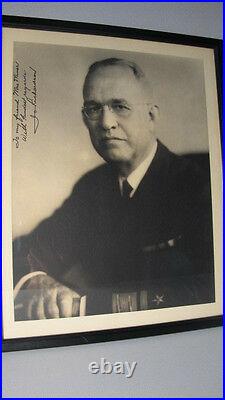
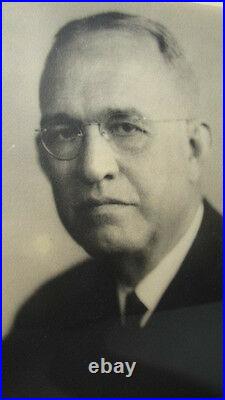
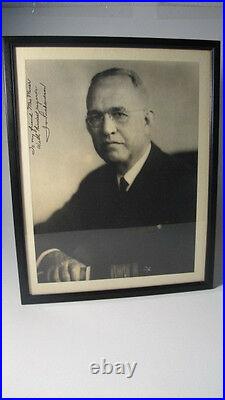
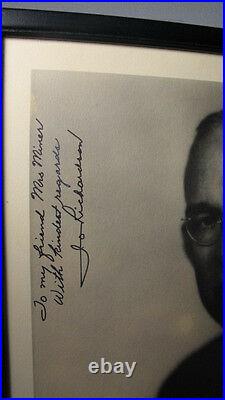
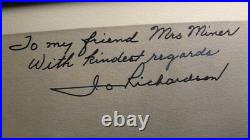

1939 US NAVY ADMIRAL J. RICHARDSON SIGNED PHOTO PEARL HARBOR WWII ROOSEVELT. A FINE SIGNED STUDIO PORTRAIT OF THE’PROPHET’ OF PEARL HARBOR, ADMIRAL JAMES OTTO RICHARDSON. Offered here is a fine, signed studio portrait of United States Navy Admiral James Otto Richardson. RICHARDSON IS NOTED FOR HAVING BEEN FIRED BY PRESIDENT ROOSEVELT FOR THEIR DISAGREEMENT ON LEAVING THE US FLEET IN PEARL HARBOR. The portrait shows Richardson in his Admiral’s dress uniform and measures 11.75 in x 14.75 in in frame. The photo is in fine condition and based on the aged backing paper and the’Veerhof Galleries’ framers label on the rear, the photo is as it was since Richardson gifted it (or prepared to gift it) soon after it was signed. Miner With kindest regards J. In addition to this photo and some others, we are also offering some amazing documents related to Richardson’s life and well documented, repeated warnings to Roosevelt and other Navy brass of the risks of leaving the US fleet in Pearl Harbor. The estate consignor, we are told, is the family trust, and as such wishes to remain private, but we wholeheartedly stand by our attribution with complete and absolute confidence. Please see the wealth of supplementary information available online regarding Richardson’s rich life and Naval career. The book’Pearl Harbor Countdown: Admiral James O. Richardson’ by Skipper Steely (2008; Pelican Publishing) is particularly informative. James Otto Richardson (18 September 1878 – 2 May 1974). Was an admiral in the United States Navy who served from 1902 to 1942. As Commander in Chief, Pacific Fleet, he protested against the redeployment of the fleet forward to Pearl Harbor, believing that a forward defense was neither practical or useful, and that the Pacific Fleet would be the logical first target in the event of war with Japan. He was subsequently relieved of command in February 1941. His concerns were to be proved justified in December. Early life and career. Richardson was born in Paris, Texas. He entered the Naval Academy in 1898 and graduated fifth in a class of eighty-five with the class of 1902. His first duty assignments were in the Asiatic Squadron, where he took part in the Philippine campaign, and, after 1905, in the Atlantic Ocean. In 1907-09, Lieutenant Richardson commanded the torpedo boats Tingey and Stockton, and the Third Division, Atlantic Torpedo Flotilla. He was a member of the first class of the Navy’s Post Graduate Engineering School in 1909-11, then served as an engineer in the battleship USS Delaware and on the staff of the Atlantic Reserve Fleet. In 1914, Richardson was promoted to the rank of Lieutenant Commander and was attached to the Department of the Navy’s Bureau of Steam Engineering, where he worked to assure the Navy’s fuel supply. World War I and interwar years. In 1917-19, Commander Richardson was navigator and executive officer of the battleship USS Nevada. Following a tour at the Naval Academy, he was given command of the gunboat USS Asheville in 1922 and took her out to Asiatic waters, where he also had command of the South China Patrol. Captain Richardson was Assistant to the Chief, Bureau of Ordnance, in 1924-27. For service with the Bureau of Navigation (BuNav). In January 1931, Captain Richardson placed the new heavy cruiser Augusta in commission and commanded her for more than two years. After a tour as a Naval War College student in 1933-34, he was Budget Officer at the Navy Department, receiving promotion to rear admiral while in that position in December 1934. He became Assistant to the Chief of Naval Operations in June 1937 and a year later became chief of the Bureau of Navigation. In June 1939, Richardson went back to sea as Commander, Battle Force (ComBatFor), U. Fleet, with the temporary rank of admiral. Pearl Harbor and aftermath. Beginning in January 1940, he was Commander in Chief, Pacific Fleet (CINCPAC). At the time of his appointment, Richardson was one of the Navy’s foremost figures. Since his earliest days, after leaving Annapolis, he had made the study of Japanese warfare his life work. He was beyond question the Navy’s outstanding authority on Pacific naval warfare and Japanese strategy. He held this position during a stressful period marked by the fleet’s forward deployment to Pearl Harbor from its traditional base in San Diego, California. Richardson protested this redeployment to President Franklin D. Roosevelt and to other politicians in Washington. He argued such a forward defense was not practical or useful, despite Japan’s attack on China and whatever promises had been made to Britain to come to their aid if attacked. According to journalist John T. It was Richardson’s belief – and indeed generally supported by the Navy – that the Fleet should never be berthed inside Pearl Harbor where it would be a mark for attack. This was particularly true in such troubled times when the airways of the East were hot with rumors of approaching conflict. What is more, Richardson held the belief that Pearl Harbor was the logical first point of attack for the Japanese High Command, wedded as it was to the theory of undeclared and surprise warfare. On October 26, 1940, a White House leak to the Washington-based Kiplinger Newsletter predicted Richardson would be removed as CinCPac. He was replaced by Admiral Husband E. Kimmel in February 1941. Upon his relief by President Roosevelt, Richardson reverted to his permanent rank of rear admiral and served as a member of the Navy General Board, and in the office of the Secretary of the Navy until to his retirement on October 1, 1942. Transferred to the retired list with the rank of admiral in October 1942, he remained on active service with the Navy Relief Society, as senior member of a “Special Joint Chiefs of Staff Committee” on the reorganization of the national defense, and as a witness before the International Military Tribunal for the Far East. Released from active duty in January 1947, he thereafter resided in Washington, D. Richardson died on 2 May 1974. Used – Very Good. Vendio Images: More than just a pretty image. 150 FREE professional templates with Vendio Sales Manager. FREE Counters used in millions of listings – Vendio! This item is in the category “Collectibles\Militaria\WW II (1939-45)\Original Period Items\United States\Photographs”. The seller is “bibliomonster” and is located in this country: US. This item can be shipped worldwide.
